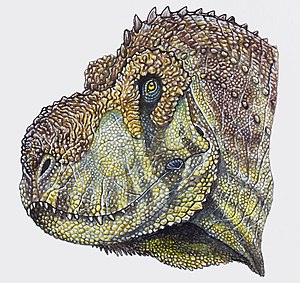Pycnonemosaurus
| Pycnonemosaurus | ||||||||||||
|---|---|---|---|---|---|---|---|---|---|---|---|---|

Artistic reconstruction of the head section of Pycnonemosaurus |
||||||||||||
| Temporal occurrence | ||||||||||||
| Turonium to Santonium ( Upper Cretaceous ) | ||||||||||||
| 93.9 to 83.6 million years | ||||||||||||
| Locations | ||||||||||||
| Systematics | ||||||||||||
|
||||||||||||
| Scientific name | ||||||||||||
| Pycnonemosaurus | ||||||||||||
| Kellner & Campos , 2002 | ||||||||||||
| species | ||||||||||||
|
Pycnonemosaurus is a little-known genus of theropod dinosaur from the group of Abelisauridae . The fragmentary remains of the only find so far come from the Upper Cretaceous ( Turonium to Santonium ) of Brazil . It is both the first formally named and currently best known Abelisaurid discovered in Brazilian territory. The relationships within the Abelisauridae cannot be determined because of the very incomplete find. This genus wasscientifically described in 2002 by Alexander Kellner and Diógenes de Almeida Campos with the only species Pycnonemosaurus nevesi .
Find
The Fund ( holotype , copy number DGM 859-R) consists of five teeth, fragments of seven caudal vertebrae, pubis (pubic), tibia (tibia) and the fragment of a fibula (fibula). He was found on the land of the Roncador farm in the Brazilian state of Mato Grosso . The fossils come from a conglomeratic sandstone , which is now included in the Adamantina Formation , a formation of the Bauru Group .
features
The approximately 9 meter long Pycnonemosaurus was probably a strongly built Abelisaurid, as indicated by the short and robust, 84.5 cm long shin, which is similar to that of the Indian Lametasaurus . As with other Abelisauriden, the ends of the diapophyses (lateral vertebral processes) of the caudal vertebrae are fan-shaped. The pubic bone is long, slender and straight when viewed from the side. Unlike other abelisaurids, the lower end of this bone has a protrusion on the anterolateral side that serves as a muscle attachment point.
supporting documents
- ^ A b c d Carlos Roberto A. Candeira, Agustín G. Martinelli, Leonardo S. Avilla, Thomas H. Rich : Tetrapods from the Upper Cretaceous (Turonian-Maastrichtian) Bauru Group of Brazil: a reappraisal. In: Cretaceous Research. Vol. 27, No. 6, 2006, ISSN 0195-6671 , pp. 923-946, doi : 10.1016 / j.cretres.2006.05.002 .
- ^ A b Fernando E. Novas : The age of dinosaurs in South America. Indiana University Press, Bloomington IN 2009, ISBN 978-0-253-35289-7, pp. 283-284.
- ^ Matthew T. Carrano, Scott D. Sampson: The Phylogeny of Ceratosauria (Dinosauria: Theropoda). In: Journal of Systematic Palaeontology. Vol. 6, No. 2, 2008, ISSN 1477-2019 , pp. 183-236, doi : 10.1017 / S1477201907002246 .
- ↑ a b Alexander WA Kellner, Diógenes de Almeida Campos: On a theropod dinosaur (Abelisauria) from the continental Cretaceous of Brazil. In: Arquivos do Museu Nacional. Vol. 60, No. 3, 2002, ISSN 0365-4508 , pp. 163-170.